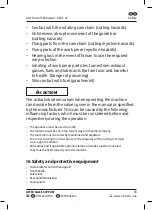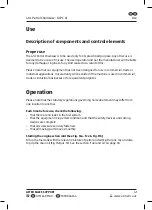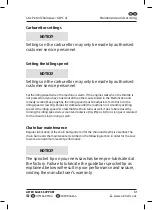
AFTER SALES SUPPORT
0151 649 1500
1890 946244
www.einhell.co.uk
47
41cc Petrol Chainsaw – GLPC 41
Use
– Never walk in front of a tree that has been notched. Make the felling cut (Fig. 14/Pos. D)
from the other side of the tree and 1.5 - 2.0 inches (3-5 cm) above the edge of the notch
(Fig. 14/Pos. C). Never saw completely through the trunk. Always leave a hinge (Fig. 14/
Pos. F). The hinge guides the tree. If the trunk is completely cut through, control over
the felling direction is lost. Insert a wedge or felling lever in the cut well before the tree
becomes unstable and starts to move. This will prevent the guide bar from binding in
the felling cut if you have misjudged the falling direction. Make sure no bystanders
have entered the range of the falling tree before you push it over.
– Before making the final cut, always recheck the area for bystanders, animals or
obstacles.
Felling cut
– Use wooden or plastic wedges (Fig. 15/pos. A) to prevent binding the bar or chain
(Fig. 15/pos. B) in the cut. Wedges also control felling (Fig. 15).
– When the diameter of wood being cut is greater than the bar length, make 2 cuts as
shown (Fig. 16).
– As the felling cut gets close to the hinge, the tree should begin to fall. When the tree
begins to fall, remove the saw from the cut, stop engine, put the chainsaw down, and
leave area along the retreat path (Fig. 13).
Fig. 16
Fig. 15
A
B
Limbing
– Limbing a tree is the process of removing the branches from a fallen tree. Do not
remove supporting limbs (Fig. 17/pos. A) until after the log is bucked (cut) into lengths
(Fig. 17). Branches under tension should be cut from the bottom up to avoid binding
the chainsaw.
– Never cut tree limbs while standing on the tree trunk.
Fig. 17
A
Summary of Contents for GLPC 41
Page 72: ......
















































